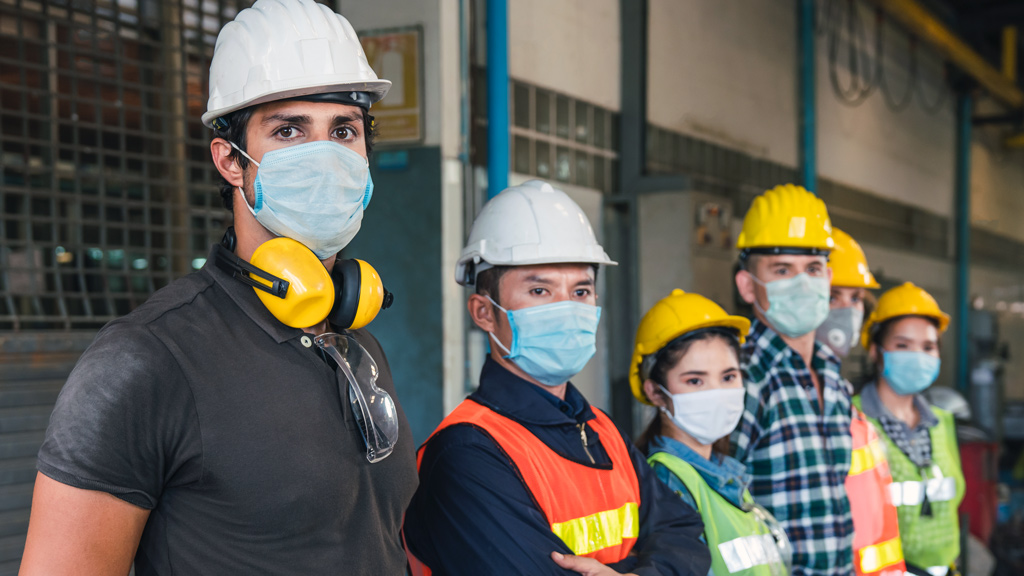An economic model created by the University of British Columbia (UBC) says construction workers face an additional risk of contracting the coronavirus because of who they live with.
According to the Vancouver School of Economics COVID Risk/Reward Assessment Tool (RRAT), construction workers, along with couriers and sheet metal workers, are in an occupation with moderate risk of contracting COVID-19.
But the model also says that many people in construction live with someone who works in healthcare, which increases their chances of catching the virus.
In fact, healthcare occupations – nurses, dentists, dental hygienists, physiotherapists, doctors – are among the riskiest. Some occupations least at risk are software engineers, graphic designers and logging machinery operators.
An occupation’s riskiness score in the model takes into account such variables as physical proximity to others, number of face-to-face contacts and whether the work is done indoors or outside.
The score also considers whether they commute to work on public transit or live in a crowded household. RRAT was developed by economists at UBC’s Vancouver School of Economics (VSE).
For more than 300 occupations in over 100 B.C. industries, it measures the risk of transmitting the coronavirus against the economic benefits of opening during the pandemic.
To find out more about RRAT, go to https://covid19.economics.ubc.ca/projects/project-1/
RRAT was used in a recent Canadian study that surveyed North American media reports to identify COVID-19 cases by worker occupation.
COVID-19 and Workplace Community Transmission/Identifying At-Risk Occupations and Vulnerable Workers collected and compared several different sets of data, including RRAT.
The study was researched and written by a team led by Mieke Koehoorn, professor of occupational health at UBC’s School of Population and Public Health, and Cheryl Peters, adjunct assistant professor, Community Health Sciences at the University of Calgary.
Koehoorn and Peters says there was a need to find new data sources to identify work-related COVID-19 cases and find out what determines the risk of infection.
“COVID-19 is more than a public health issue,” said Koehoorn. “The workplace has many risk factors for transmission of the virus, which means it is where much of the transmission takes place.”
Koehoorn and Peters say an effective public (emphasis added) health strategy needs to consider the risk of exposure to the virus at work and what factors determine workplace (emphasis added) transmission of the virus.
“There is little data in Canada that links occupation or work characteristics with infectious disease cases,” said Koehoorn. “France and Italy and some other jurisdictions, however, are intending to collect statistics by occupation.”
In B.C., an occupation is noted and collected in COVID-19 case reports for healthcare workers only.
Koehoorn and Peters say new, creative approaches are needed to identify other workers and occupations at risk of exposure to the virus and workplace transmission.
They and their team of seven surveyed English-language media articles published between February 2020 and July 2020 to identify workers and workplaces with COVID-19.
After examining 400 media articles, they found 220 unique outbreaks in Canada and the U.S.
To identify risk groups, occupations with reported COVID-19 cases were compared with occupations in the VSE’s RRAT risk assessment tool and with workers’ compensation claims.
Then experts in occupational hygiene and epidemiology reviewed the cases to determine the risk factors of workplace outbreaks and transmission.
Most of the occupations with COVID-19 cases identified in media articles tended to be labourers in construction, oil and gas, processing, manufacturing, mining, public workers, mineral and metal processing; operators in food and beverage processing, transportation, power systems and oil and gas; and assemblers/inspectors in such sectors as motor vehicle, environmental and OHS, mechanical, electrical).
Koehoorn and Peters found here are three main ways workers were infected with the virus:
- Working closely to co-workers (e.g. construction) and being in close contact with people outside of work;
- Being in direct contact with patients (e.g. nurses), or with the public (e.g. police officers); and
- Being in contact with the public (e.g. cashiers, transit workers and correctional officers).
From COVID-19 and Workplace Community Transmission:
“The COVID-19 pandemic has illuminated and magnified the intersection of public health and occupational health where exposure for workers is exacerbated by working conditions that are socially determined.
These social determinants of health (e.g. low incomes, job insecurity, few or no job benefits), and not simply proximity, likely explain the breadth of occupations across sectors with COVID-19 outbreaks reported in the media and beyond those captured by other risk assessment indicators.”











Recent Comments